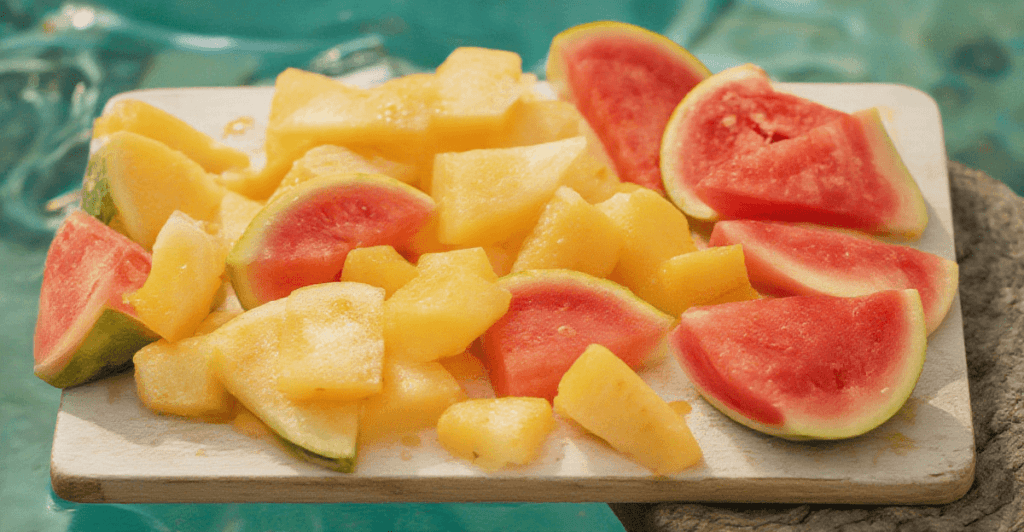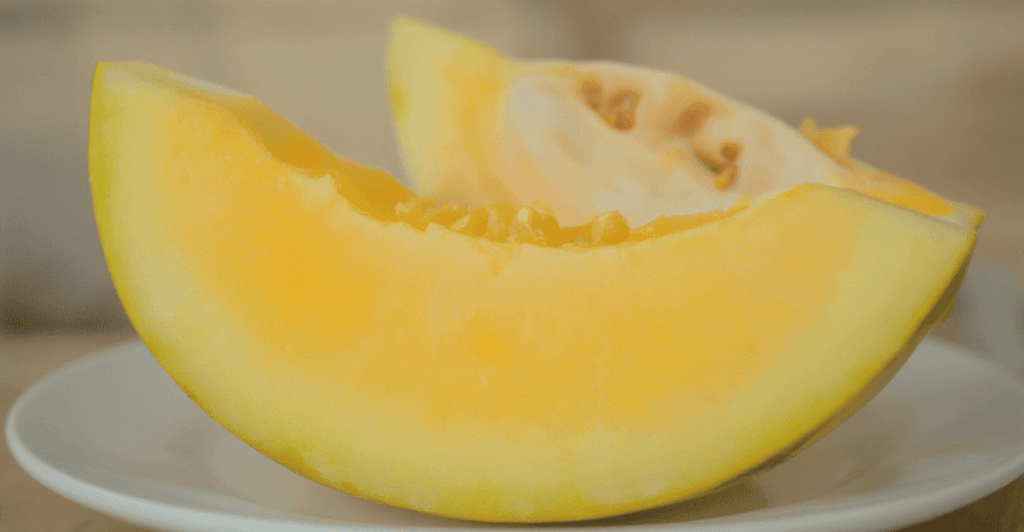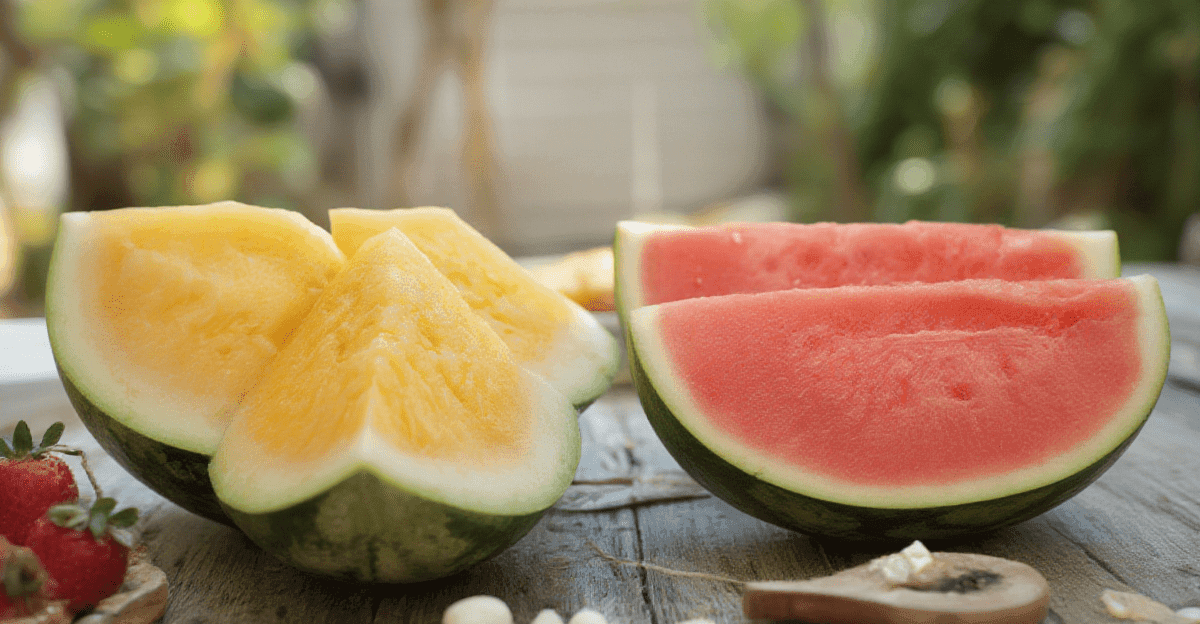Introduction
Watermelon is one of the most beloved summer fruits, cherished for its juicy, refreshing taste and high water content. However, most people are only familiar with the classic pink or red watermelon. Do yellow and pink watermelon taste the same? Yellow watermelon, with its strikingly bright flesh, is often mistaken for being an entirely different fruit.
This raises the question: Do yellow and pink watermelons taste the same? While they share a similar appearance on the outside, their taste and characteristics might surprise you. This article will compare these two varieties of watermelon, exploring their taste, nutritional value, origin, and unique differences.
From flavor profiles to farming practices, we’ll answer all your questions about these colorful melons. Do yellow and pink watermelon taste the same? We’ll help you decide which one is worth a bite!
What is the Difference Between Yellow and Pink Watermelons?

Watermelons are loved worldwide for their juicy and refreshing taste. While the classic pink or red varieties are the most well-known, yellow watermelons are gaining popularity. Do yellow and pink watermelons taste the same? Let’s dive into the key differences between these two types of watermelons.
Appearance: How to Identify Yellow and Pink Watermelons
At first glance, yellow and pink watermelons look the same from the outside. They both have a green striped or solid rind. However, the big difference is inside.
- Pink Watermelon: When you slice a pink watermelon, the flesh is bright pink or red. This color comes from a pigment called lycopene, which is also found in tomatoes.
- Yellow Watermelon: Yellow watermelons have a golden or bright yellow flesh. This vibrant color comes from a different pigment called beta-carotene, the same pigment that gives carrots their orange color.
In short, the primary difference in appearance is the color of the flesh—pink or red for one and yellow for the other. Do yellow and pink watermelons taste the same? While they look different, their flavors also have slight variations.
Origin and History of Yellow and Pink Watermelons
You might be wondering: where did yellow watermelon come from? Both types of watermelon actually have a long history that dates back thousands of years.
- Pink Watermelon: Pink watermelons are the most common variety today, and they are thought to have originated in Africa. Over time, farmers grew varieties that developed the sweet red or pink color we know now.
- Yellow Watermelon: Surprisingly, yellow watermelon is older than the pink variety! It was one of the original types of watermelon found in Africa. Unlike pink watermelons, yellow ones have been naturally grown and selected for their unique color and flavor.
In summary, yellow watermelon is considered the “original” version of the fruit, while pink watermelon gained popularity over time for its vibrant color and sweetness. Do yellow and pink watermelons taste the same? Although both are delicious, their flavors have subtle differences that set them apart.
Do Yellow and Pink Watermelons Have the Same Taste?
Now, let’s address the question everyone is curious about: Do yellow and pink watermelons taste the same? The short answer is no—they don’t taste the same. While both are sweet, juicy, and refreshing, their flavors have subtle differences. Let’s break it down in more detail.
Flavor Profile of Yellow Watermelon
Yellow watermelons have a unique and slightly different flavor compared to pink watermelons. People often describe the taste as:
- Sweeter and milder: Yellow watermelons tend to have a sweeter, honey-like flavor. It’s not as strong or “watery” as the taste of pink watermelon.
- Refreshing and tropical: Some people say yellow watermelon has a hint of tropical fruit flavor, like mango or honeydew melon. This makes it taste a bit more exotic.
- Crisp and light: Yellow watermelons have a firm and crisp texture, which adds to their refreshing taste.
Do Yellow and Pink Watermelons Have the Same Taste?

Now let’s answer the big question: Do yellow and pink watermelons taste the same? The simple answer is no, they don’t taste exactly alike. While both are sweet and juicy, their flavors have some differences. Let’s look at each one closely.
The Taste of Yellow Watermelon
Yellow watermelon has a unique and slightly surprising flavor. Here’s how people often describe it:
- Sweeter: Yellow watermelons usually taste sweeter than pink ones. The sweetness is light and often compared to honey.
- Milder: The flavor of yellow watermelon is not as strong as the pink variety. It’s gentle, smooth, and refreshing.
- A hint of tropical fruit: Some people say yellow watermelon reminds them of tropical fruits, like mango or honeydew melon. This gives it a unique, exotic twist.
In short, yellow watermelon tastes sweeter, smoother, and sometimes fruitier. Its light flavor makes it a favorite for those who like something less intense.
The Taste of Pink (Red) Watermelon
Pink watermelons, on the other hand, have the classic watermelon flavor most of us know and love. Here’s what makes their taste stand out:
- Rich and bold: Pink watermelons have a stronger, more traditional watermelon taste. It’s sweet but also has a slight “watery” or refreshing tang.
- Balanced flavor: While pink watermelons are sweet, they have a balance of sweetness and juiciness. This makes them very satisfying on hot summer days.
- Crisp and refreshing: Pink watermelon is known for its juicy, crisp texture that bursts with flavor when you bite into it.
In simple terms, pink watermelons offer the classic, bold watermelon flavor that is both sweet and refreshing. Do yellow and pink watermelons taste the same? While similar, the slight differences in taste make each variety unique.
Why Do They Taste Different?
You might be wondering why yellow and pink watermelons taste different if they’re both watermelons. There are a few reasons:
- Pigments: Pink watermelons get their color from a pigment called lycopene, which gives tomatoes and red fruits their flavor and color. Yellow watermelons, however, contain beta-carotene, the same pigment found in carrots. These pigments can slightly change the taste.
- Sugar Content: Yellow watermelons often have more natural sugars than pink ones. This makes them taste sweeter.
- Variety: Farmers grow different types (or varieties) of watermelon. Some types are naturally sweeter, juicier, or crisper, depending on how they are grown.
Which One Should You Choose?
So, which watermelon is better? It really depends on your taste preference:
- If you like a sweeter, honey-like flavor, go for the yellow watermelon.
- If you prefer the classic watermelon taste that’s bold and refreshing, choose the pink watermelon.
No matter which one you pick, both types are delicious, juicy, and perfect for summer.
Nutritional Comparison: Yellow vs Pink Watermelon
Now that we know how yellow and pink watermelons taste, let’s talk about their nutrition. Are they the same when it comes to health benefits? The answer is that they are quite similar, but there are a few small differences. Let’s look at their calories, vitamins, and other important nutrients.
Calories and Sugar Content
Both yellow and pink watermelons are low in calories, which makes them a great snack. Here’s a quick comparison:
- Yellow Watermelon: It has about 45–50 calories per cup. This makes it slightly sweeter because of its natural sugars.
- Pink Watermelon: A cup of pink watermelon has about 40–45 calories. It’s still sweet but has a little less sugar than the yellow variety.
As you can see, the difference in calories is minimal. Do yellow and pink watermelon taste the same? Whether you choose yellow or pink watermelon, both are low-calorie and nutritious choices that make for a healthy snack.
Vitamins and Antioxidants
Watermelons, regardless of their color, are full of essential vitamins and nutrients. Do yellow and pink watermelon taste the same? While they share many benefits, there are a few key differences to note.
- Pink Watermelon:
- It is rich in lycopene, an antioxidant that gives it its red or pink color. Lycopene is great for your heart health and can help protect your body from damage caused by free radicals.
- It also has a good amount of vitamin C, which helps keep your immune system strong.
- Yellow Watermelon:
- Yellow watermelons contain beta-carotene, the same antioxidant found in carrots. Beta-carotene is good for your eyesight and helps keep your skin healthy.
- It also has a similar amount of vitamin C, so it’s still great for boosting your immune system.
In simple words, pink watermelons are great for heart health because of lycopene, while yellow watermelons are better for your eyes and skin because of beta-carotene. Both are full of antioxidants that help you stay healthy.
Water Content and Hydration
Did you know that watermelon is made up of about 90% water? This is true for both yellow and pink varieties. Their high water content makes them:
- Perfect for staying hydrated on hot summer days.
- A great snack for anyone who wants to stay full without eating too many calories.
So, whether you eat yellow or pink watermelon, both will keep you refreshed and hydrated.
Which One is Healthier?
When it comes to health benefits, both yellow and pink watermelons are great choices. Here’s a quick summary:
- Yellow watermelon is slightly sweeter and has more beta-carotene, which is good for your skin and eyes.
- Pink watermelon has lycopene, which is better for your heart and overall cell protection.
In the end, both are packed with vitamins, minerals, and antioxidants. You can enjoy either one knowing that they’re both healthy and refreshing.
Are Yellow and Pink Watermelons Grown Differently?
Now that we’ve discussed taste and nutrition, you might be wondering: Are yellow and pink watermelons grown the same way? Do yellow and pink watermelon taste the same? The answer is yes—both are cultivated similarly, though there are slight differences depending on the variety. Let’s take a closer look at how farmers grow these colorful fruits.
How Yellow Watermelons Are Grown
Yellow watermelons grow just like pink watermelons, but they come from seeds of special watermelon varieties. Here’s how it works:
- Choosing the Right Seeds: Farmers use seeds that naturally grow yellow-fleshed watermelons. These seeds have been developed over time to produce sweeter and crisper fruit.
- Planting: Farmers plant yellow watermelon seeds in warm soil. Watermelons grow best in sunny and hot climates, where the temperature stays above 70°F (21°C).
- Water and Care: Yellow watermelons need plenty of water, especially during hot days. Farmers carefully water the plants to keep the soil moist but not too wet.
- Harvesting: It takes about 70–90 days for yellow watermelons to grow and ripen. Farmers know a watermelon is ready when the bottom (where it touches the ground) turns a creamy yellow color.
Since yellow watermelons are not as common, they are grown in smaller amounts compared to pink watermelons. You might see them more often at farmers’ markets or specialty stores.
How Pink (Red) Watermelons Are Grown
Pink watermelons are the most common type of watermelon grown around the world. They are also grown using specific steps:
- Choosing the Seeds: Farmers use seeds that produce red or pink flesh. These seeds have been selected over many years to grow sweeter, juicier watermelons.
- Planting: Just like yellow watermelons, pink watermelons need warm soil and lots of sunlight. Farmers plant the seeds in rows or hills to give the vines space to spread.
- Watering: Pink watermelons need regular watering to stay healthy. If they don’t get enough water, they won’t grow as big or juicy.
- Harvesting: It also takes about 70–90 days for pink watermelons to ripen. Farmers check the bottom of the watermelon for a creamy yellow color, which means it’s ready to pick.
Since pink watermelons are so popular, they are grown in much larger amounts. You can easily find them in grocery stores and markets all around the world.
Do Farmers Use Chemicals or Pesticides?
Both yellow and pink watermelons are often grown with care to avoid pests and diseases. However, some farmers may use pesticides to protect the plants. To enjoy safer, chemical-free watermelons, you can:
- Buy organic watermelons. Organic farmers don’t use synthetic chemicals, which makes their fruit a healthier choice.
- Wash your watermelon well before cutting it. This removes dirt and any residue on the rind.
Why Aren’t Yellow Watermelons as Common?
One reason yellow watermelons are less common is that many people simply don’t know about them. Do yellow and pink watermelon taste the same? Farmers tend to prioritize growing pink watermelons because they are more popular and easier to sell. However, as awareness of yellow watermelons grows, they are slowly becoming more available in stores.
Can You Grow Watermelons at Home?
Yes, you can grow both yellow and pink watermelons at home if you have a garden! Here’s what you need to do:
- Choose seeds for the type of watermelon you want (yellow or pink).
- Plant the seeds in a sunny spot with warm soil.
- Water the plants regularly and give them space to grow.
- After about 2–3 months, you’ll have fresh, homegrown watermelons to enjoy!
In short, both yellow and pink watermelons are grown in similar ways, but yellow ones are less common. If you ever get the chance to try growing your own, it’s a fun and rewarding experience!
Part 6: Which Type of Watermelon is Sweeter and Healthier?
Now that we’ve learned about how yellow and pink watermelons are grown, let’s talk about which one is sweeter and healthier. While both types are delicious and good for you, they have small differences. Let’s take a closer look!
Which Watermelon is Sweeter?
When it comes to sweetness, yellow watermelon often wins. Here’s why:
- Natural sugars: Yellow watermelons usually have more natural sugar, which gives them their honey-like taste.
- Milder flavor: Yellow watermelons don’t have the same strong, tangy flavor as pink ones. Instead, they taste smooth and sweet, almost like tropical fruit.
- Varieties: Some yellow watermelon varieties are grown specifically to be extra sweet, which is why many people find them tastier.
On the other hand, pink watermelons are known for being very sweet and refreshing. Do yellow and pink watermelons taste the same? Pink watermelons often have a stronger, bolder watermelon flavor that many people love.
In short, if you like fruit with a light, extra-sweet flavor, you might enjoy yellow watermelon more. But if you prefer the classic watermelon taste, stick with the pink variety.
Which Watermelon is Healthier?
Both yellow and pink watermelons are healthy choices because they are low in calories, full of water, and packed with vitamins. However, they each offer slightly different health benefits:
- Yellow Watermelon:
- Contains beta-carotene, the same nutrient found in carrots. Beta-carotene is great for your eyesight and helps keep your skin glowing.
- Provides a good amount of vitamin C, which helps strengthen your immune system.
- Pink Watermelon:
- Contains lycopene, a powerful antioxidant that is good for your heart health and may help protect your cells from damage.
- Also has plenty of vitamin C, which keeps you healthy and energized.
Both types of watermelon have a lot of water, so they keep you hydrated and help you feel full. This makes them perfect snacks, especially on hot summer days.
Quick Comparison: Yellow vs. Pink Watermelon
| Nutrient | Yellow Watermelon | Pink Watermelon |
| Beta-Carotene | High (good for eyes and skin) | Low |
| Lycopene | Low | High (good for heart health) |
| Natural Sugar Content | Slightly higher (sweeter taste) | Slightly lower |
| Vitamin C | Good source | Good source |
| Water Content | About 90% (very hydrating) | About 90% (very hydrating) |
Which One Should You Pick?
Choosing between yellow and pink watermelon depends on what you’re looking for:
- If you want a sweeter, tropical flavor, go for yellow watermelon.
- If you prefer a classic, bold watermelon taste, stick with pink watermelon.
- If you’re looking for specific health benefits, remember:
- Yellow watermelon is great for your eyes and skin (because of beta-carotene).
- Pink watermelon is good for your heart and overall health (thanks to lycopene).
At the end of the day, both types of watermelon are healthy, refreshing, and delicious. You really can’t go wrong with either choice!
Final Thoughts
Both yellow and pink watermelons are ideal for hot days, family picnics, or as a healthy snack. Do yellow and pink watermelon taste the same? While they share a sweet, refreshing quality, their flavors have subtle differences. Whether you go for the classic pink variety or the unique yellow kind, you’ll enjoy a juicy, delicious treat that’s also packed with health benefits!
FAQs
1. Is a yellow watermelon natural?
Yes, yellow watermelon is completely natural. It is not genetically modified. In fact, yellow watermelons have been around for thousands of years, even longer than the pink or red varieties. The yellow color comes from beta-carotene, a natural pigment found in foods like carrots and sweet potatoes. Farmers grow yellow watermelons using seeds from specific varieties, just like they do with pink watermelons.
2. Is it okay to eat a yellow watermelon?
Absolutely! Yellow watermelon is perfectly safe to eat and just as healthy as pink watermelon. It is full of vitamins, antioxidants, and natural sugars that give it a sweet and refreshing taste. You can enjoy it in slices, as a juice, or even in salads. Just make sure to wash the outside of the watermelon before cutting it, just like you would with any fruit.
3. How rare is a yellow watermelon?
Yellow watermelons are not as common as pink watermelons, so they can be considered rare, especially in regular grocery stores. Farmers grow yellow watermelons in smaller amounts because many people are still unfamiliar with them. However, you can sometimes find them at farmers’ markets, specialty stores, or during the summer in certain regions. As more people learn about yellow watermelons, they are becoming easier to find.
Conclusion
Yellow and pink watermelons are both tasty, healthy, and perfect for staying cool and hydrated. While yellow watermelon has a sweet, tropical flavor and is good for your eyes, pink watermelon offers that classic taste and is great for heart health.
If you’ve never tried yellow watermelon before, give it a chance—you might be pleasantly surprised! In the end, no matter which one you choose, you’ll enjoy a juicy, refreshing snack that’s as good for your body as it is for your taste buds.

